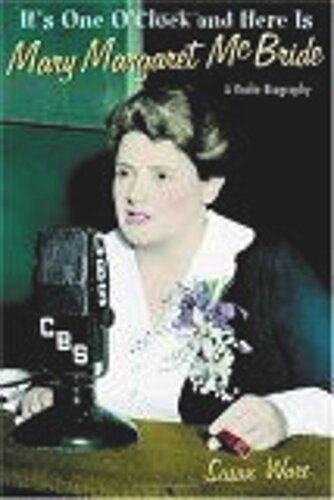

Most ebook files are in PDF format, so you can easily read them using various software such as Foxit Reader or directly on the Google Chrome browser.
Some ebook files are released by publishers in other formats such as .awz, .mobi, .epub, .fb2, etc. You may need to install specific software to read these formats on mobile/PC, such as Calibre.
Please read the tutorial at this link: https://ebookbell.com/faq
We offer FREE conversion to the popular formats you request; however, this may take some time. Therefore, right after payment, please email us, and we will try to provide the service as quickly as possible.
For some exceptional file formats or broken links (if any), please refrain from opening any disputes. Instead, email us first, and we will try to assist within a maximum of 6 hours.
EbookBell Team

4.4
62 reviewsOne of the most beloved radio show hosts of the 1940s and 1950s, Mary Margaret McBride (1899—1976) regularly attracted between six and eight million listeners to her daily one o'clock broadcast. During her twenty years on the air she interviewed tens of thousands of people, from President Harry Truman and Frank Lloyd Wright to Rachel Carson and Zora Neale Hurston. This is her story.
Five decades after their broadcast, her shows remain remarkably fresh and interesting. And yet McBride—the Oprah Winfrey of her day—has been practically forgotten, both in radio history and in the history of twentieth-century popular culture, primarily because she was a woman and because she was on daytime radio.
Susan Ware explains how Mary Margaret McBride was one of the first to exploit the cultural and political importance of talk radio, pioneering the magazine-style format that many talk shows still use. This radio biography recreates the world of daytime radio from the 1930s through the 1950s, confirming the enormous significance of radio to everyday life, especially for women.
In the first in-depth treatment of McBride, Ware starts with a description of how widely McBride was revered in the mid-1940s—the fifteenth anniversary party for her show in 1949 filled Yankee Stadium. Once the readers have gotten to know Mary Margaret (as everyone called her), Ware backtracks to tell the story of McBride’s upbringing, her early career, and how she got her start in radio. The latter part of the book picks up McBride's story after World War II and through her death in 1976. An epilogue discusses the contemporary talk show phenomenon with a look back to Mary Margaret McBride’s early influence on the format.